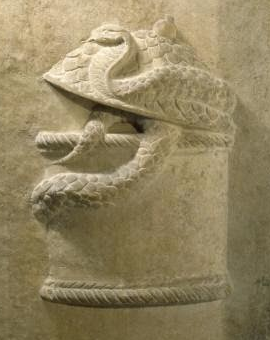Ancient Psychedelia: Alien Gods & Mushroom Goddesses
Online Book - Chapter 14, Page 282
Back to Online Book Mainpage / Next Page (Chapter 14, Page 283)
| The worship of Isis ended up being useful to Rome in aiding to establish the worship of the Virgin Mary alongside Jesus. Many of the rites and observations of Isis were consistent enough with what Rome had in mind that it was easier to assimilate Isis to Mary than it was for Rome to accomplish this with other deities. (124) During the Late Imperial Roman era, a sanctuary of Isis stood on the right bank of the Tiber on the site of the present-day St. Peter’s Basilica. Excavations of the site revealed several taurabolium altars on this previously sacred ground. (125) The Temple of Isis was burned down in AD 3 (126) but later restored by Augustus. (127) The worship of Isis continued in the Egyptian kingdom long after its suppression in other Roman held territories due to the long-standing traditions of influence in the Nubian culture and lasted up to the fifth century AD, approximately a century or two after the Roman temples were extinguished. (128) A gravestone of a priestess of Isis depicts a snake atop a pot, opening the lid and the pot top makes up the cap of the mushroom, while the serpent tail creates the imagery of the stem (41f).  (41f) Priestess of Isis Gravestone Bona Dea was a goddess of Rome who was associated with fertility and healing and somehow became associated with chastity. She was associated with the goddess Fauna who could prophecy the fates of women. She was thought to have been brought from Magna Graecia during the Early or Middle Republic, where there existed a large Aegean population. Her worshippers were allowed privileges not afforded to the Roman population such as strong wine drinking and blood sacrifice, while men were not allowed the knowledge of her worship. Her chief temple on the Aventine in Rome was supposed to have been a herbarium, stored with medicinal herbs. (129) Celebrations of Bona Dea and her persona most similarly characterize Demeter and the Thesmophoria from earlier Greek traditions. The great festival of Bona Dea was held on May 1, but she was also honored at festivals of Faunus, especially the Faunalia Rustica on Dec. 5. (129) |
According to Macrobius, the Books of the Pontiffs (pontificum libri) treated Bona Dea, Fauna, Ops, and Fatua as names for the same goddess, Maia. (130) The Virgin Mary The Roman Emperor Constantine was the first Christian Emperor to abolish the worship of Mary in Rome, but, like their persistent trouble with the Isis sect followers, all of the former feminine mystery worship and celebrations were difficult to extinguish for the church and took a long period of time before they were able to rid the ideas from the common people. (131) The “Virgin Mary” has been fused in cultures like contemporary Crete where she is referred to as “Virgin Mary of the Bear,” due to a longstanding association of the goddess with the bear. (132) In Ireland, the goddess Brigid, a goddess of poetry, became St. Brigit the Virgin as Muse, where she went by the title, “Virgin Mary of the Gael.” (133) In The Litany of The Blessed Virgin Mary, also known as the Litany of Loreto, the Virgin is attributed the following features and epithets which may sound familiar as epithets of the goddess in ancient history. It was used in the 16th century and approved in 1587 by Pope Sixtus V: “Mystical rose,” “Tower of David,” “Tower of ivory,” “House of gold,” “Ark of the covenant,” “Gate of Heaven,” “Morning star,” “Health of the sick,” “Refuge of sinners,” “Comforter of the afflicted” as well as “Queen assumed into Heaven.” (134) Another name for the Virgin Mary is “Our Lady of the Pillar,” a fitting title for the mushroom. (124) Healing Gods, p. 481; G. Showerman, “Isis,” in ERE vii, 435-437; also, Preller, Romische Mythologie, ii, p. 373-385 (125) ibid, p. 486; Corpus Inscriptionum Latinarum, vi, 497-504; Inscriptiones Graecae xiv, 1019, 1020 (126) Valerius Maximus, I, viii, 11-unconfirmed (127) Healing Gods, p. 483; Monumentum Ancyranum, iv, 8-Unconfirmed (128) ibid, p. 68; Budge, Gods, ii, 202-240; also Muller, pp. 98-101; Petrie in ERE v, 246; Milne, in ib., 378; G. Showerman, “Isis,”, in ib., vii, 434-437 (129) ibid, p. 419 (130) https://en.wikipedia.org/wiki/Bona_Dea (131) White Goddess, p. 395 (132) Goddesses and Gods, p. 200 (133) White Goddess, p. 394 (134) Occidental Mythology, p. 45-45 |
Go Back to Page 281